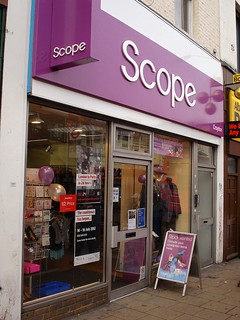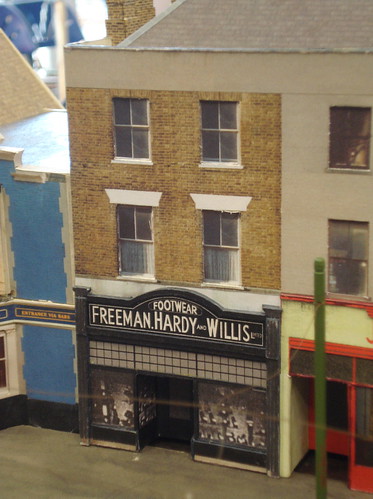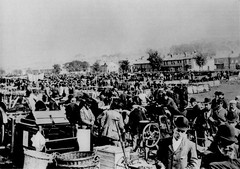The current occupant of 3 London Road is a Scope charity shop. Scope is a charity providing support and information to disabled people and their families, as well as running campaigns to fight prejudice, ensure equal inclusion in society, and work towards better support and services.
The shop at 3 London Road opened as a National Spastics Society shop in September 1993,[1] and rebranded following the parent charity to Scope in early 1995.[2] Although it's quite small in terms of physical size, it's well-stocked with clothes, shoes, kitchenware, and ornaments. They've even found room for a small changing room at the back.
1840s–1870s: Construction of the building, and Henry Davis, butcher
The building that houses the shop was probably constructed between 1847 and 1859; neither the 1844 tithe map nor Roberts’ 1847 map[3] show any buildings other than the Fox & Hounds pub on the west side of this section of London Road. Its first appearance in historical street directories[4] is in 1859, with the occupant listed as Henry Davis, butcher.
1870s–1900s: Rabbits & Sons, boot and shoe manufacturers
Some time around 1878, its tenure as a butcher’s shop came to an end as the boot and shoe manufacturers Rabbits & Sons moved in.[5] Rabbits & Sons, originally of Newington Butts, already had multiple branches elsewhere at the time.[6] Their new London Road premises were prominently placed next to the Fox & Hounds pub, and the frontage featured discreet advertising on all three floors as well as overhanging lamps to illuminate the ground-floor entrance.[7]
1900s–1950s: Freeman, Hardy & Willis
Throughout most of its history, the building has been occupied by some form of shoe shop. Rabbits & Sons were acquired by fellow shoe retailers Freeman, Hardy & Willis in 1903,[8] though street directories continue to list Rabbits & Sons at 3 London Road until around 1909, when the branding changed to Freeman, Hardy & Willis. It’s noteworthy that the same manager — Arthur Ashby — is listed from 1901 right through to 1910, so there does seem to have been some continuity of service during this period.
Freeman, Hardy & Willis merged with Sears in 1929,[9] but 3 London Road continued to operate under the Freeman, Hardy & Willis name until at least 1956. By 1980, the branding had changed to Curtess,[10] one of Sears’ shoe shop chains,[11] and Curtess seems to have remained in place until the opening of the current charity shop in September 1993.[12]
The Scope shop at 3 London Road still sells shoes today, as illustrated below — a nice link with the past.
Until recently, they used to have a pretty good book selection too — earlier this year, I went in five days in a row, and each time I found new books in stock that I wanted to read. Sadly, as of the time of writing they no longer sell books, but have given over the space to more clothing.
The goods are well-priced; while hunting for a teapot for my sister recently, I saw several in Oxfam shops priced at around £10 and up, but was able to pick up the one pictured below for a mere £2 at the London Road Scope. I've also donated goods here several times, and the staff are always really friendly and helpful.
Thanks to: Katie Adams at Scope head office; the staff at the London Road Scope shop; Brian Gittings; John Clarke; Colin Withey; all at the Croydon Local Studies Library; and my beta-reader Kerry.
Footnotes and references
- There was also a “Spastics Shop” further up London Road in the mid-1980s, at number 23 (now occupied by Prestige Barber). I haven't been able to find out whether this simply moved from number 23 to number 3 in 1993, or whether the older shop closed down some time before the newer one opened.
- Information on the opening date and rebranding date was supplied by Scope head office. More information on the rebranding can be found in The Spastics Society to Scope by James Rye. Note that the society as a whole rebranded in 1994, but the change to the shop fascias took around 9 months after that.
- Historical maps consulted at Croydon Local Studies Library.
- Historical street directories consulted at Croydon Local Studies Library. This address was renumbered from 2 to 3 London Road in 1890, and remained the same through a later renumbering that took place in 1927. The next-door address, (originally 3 London Road, now 5 London Road) also appeared for the first time in the same 1859 directory, while the next few addresses further up weren’t listed until 1864 or later. Looking at numbers 3 and 5 today, it seems plausible that they were constructed together.
- Ward’s 1874 and Wilkins’ 1876-7 list “Henry Davis, Butcher” and “H Davis, butcher” respectively; Ward’s 1876 says the address is unoccupied; and Worth’s 1878 and Atwood’s 1878 list “Rabbits, boot warehouse” and “Rabbits & Son, boot and shoe-manufacturers” respectively. The discrepancy between Wilkins’ 1876-7 and Ward’s 1876 may be due to differences in publication deadlines.
- “Rabbits and Sons Ltd., of Newington Butts, London” are mentioned on the National Archives website. Mark Bryant’s MA Thesis Retailing, Advertising and the Making of London's Victorian Middle-Class (University of New Brunswick, Canada, 1999) states that “even P. Rabbits & Sons and Pocock Brothers had established shoe store multiples by the 1870s.”
- Information on the appearance of the building during its tenure as a Rabbits branch comes from an old postcard in my possession; there’s no date given for the image, but the presence of F A Egleton next door suggests that it was before 1904.
- Information on the Freeman, Hardy & Willis takeover of Rabbits & Sons taken from the National Archives website. For more information, including images of historical ephemera relating to Freeman, Hardy & Willis, see Grace’s Guide.
- Information on the Sears merger is taken from the FundingUniverse entry for Sears, which also states that “[t]he two retail chains continued to trade separately under their old names and by the 1950s had over 900 shops between them.”
- Information on the occupant as of 1980 is taken from a journal written in that year by Brian Gittings, which includes a list of all retail premises in central Croydon. Brian very kindly lent me this journal to help with my historical research. The Curtess sign is just visible on the left-hand side of Paul Featherstone's mid-80s photo of the 119 bus.
- According to Nigel Cope in The Independent, Sears finally sold off the Curtess chain in February 1996.
- Curtess is listed at 3 London Road in the 1984-5, 1986-7, and 1988-89 London Shop Surveys (consulted at the Croydon Local Studies Library). A photo consulted in the Croydon Local Studies Library, dated 3 June 1993, shows the Curtess frontage and a “to let” sign. As mentioned above, the Scope shop (then branded as National Spastics Society) opened in September 1993.




